These are the quick & dirty travel notes from our second ThingsCon trip to Shenzhen, China. Read all posts from this series here (tag: ViewSourceII), or all blog posts relating to Shenzhen here (tag: Shenzhen). The latter one includes last fall’s trip to Shenzhen as well.
It’s ThingsCon Shenzhen day! I feel I’ve fully arrived: I’m totally in zen mode, happy to be in the moment and go with the flow.
///
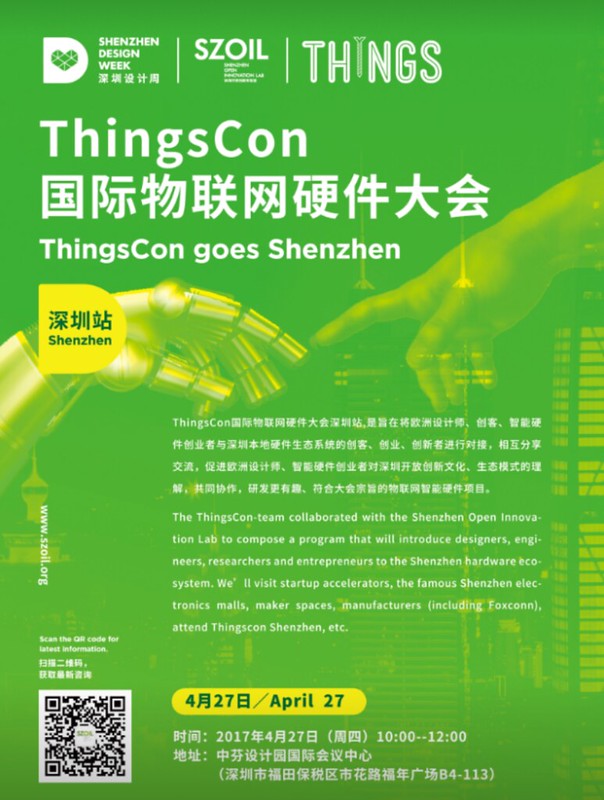
Flyer for ThingsCon Shenzhen
A big thank you to David Li and Vicky of the Shenzhen Open Innovation Lab (SZOIL) for making this event happen!

SZOIL

ThingsCon Shenzhen, doors open!
///
Before the event starts, we have a little team huddle with David. He catches us up on some recent developments.
He shares the story of the kid from Laos who came to Shenzhen and built POS machines for Lagos’ street markets. It’s easy to forget that there are a lot of very, very different markets and approaches within IoT, and that Shenzhen truly manufactures for the whole world.
Today it’s cheaper to build a smart TV that runs Android than building a non-smart TV, David explains. The economics of large scale production can do wonderful, weird, twisted things.
A large shenzhai phone maker started making an electric car. We look it up: It looks a little like a golf cart and the interior seems cobbled together from medical equipment; it has no doors. But it’s a fully functional electric car. It’s about $1.000.
///
There are around 50 people at the event, with a great mix of locals and visitors. Entrepreneurs, designers, some folks from incubators: a solid mix, it seems.
In Shenzhen, like everywhere, the movers and shakers seem to be the connectors that hop from place to place: Hong Kong, Taipei, Kuala Lumpur, Singapore, London…
///
Please note: The following are quick and dirty notes from some of the presentations. I paraphrased as best as I could to keep up.

David opening ThingsCon Shenzhen
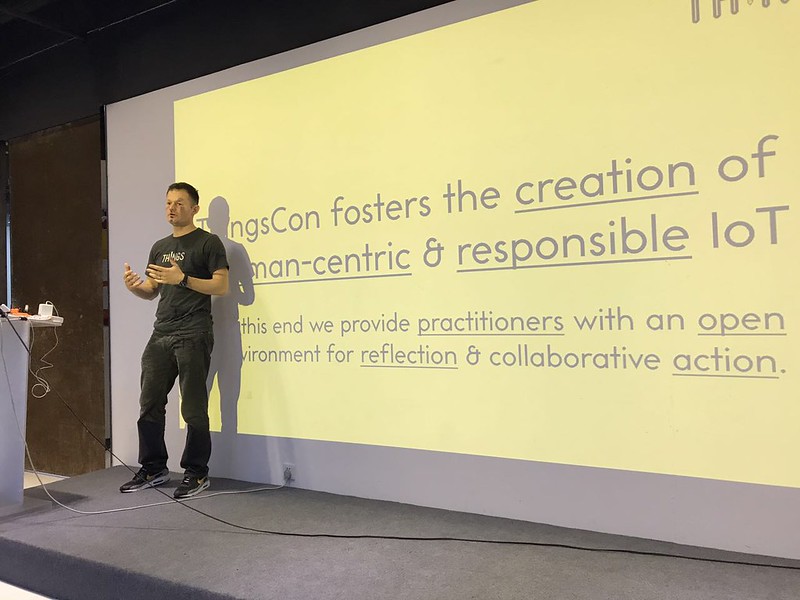
My opening — always be repeating the ThingsCon mantra! (Thanks for the photo, Dietrich!)
///
Jakie Yin of Rone Design is first. He showcases a wide range of connected industrial designs his company has been involved in. He also explains three distinct development phases for hardware:
- Zero to one
- One to hundreds
- Hundreds to X
Each of them requires different skill sets, and/or partners. His company can help with pretty much all of them.
///
Gabriel Ionut Zlamparet gives an intro to remanufacturing of used medical devices. Remanufacturing, re-use, designing for re-use has huge potential for sustainability. He share slides with great level of details.
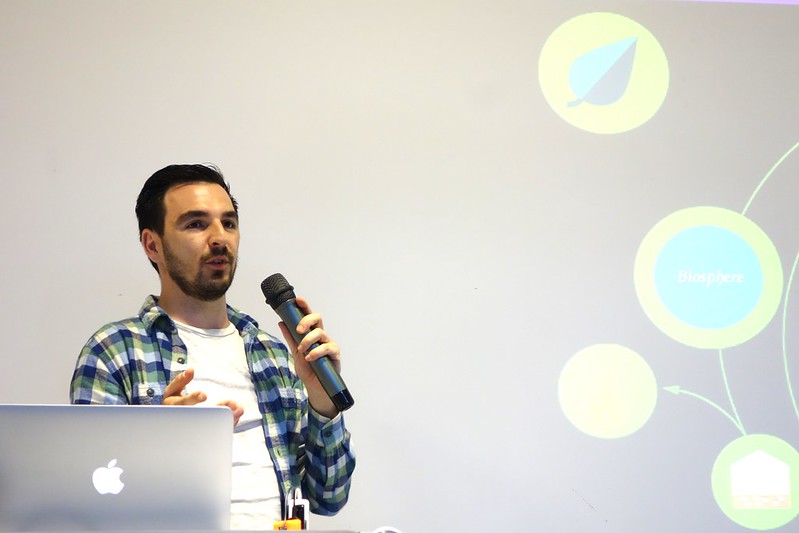
Gabriel
Gabriel’s talk stresses the importance of design for re-use, refurbishment, longevity.
I learn a lot in little time. Below some of the slides that stood out for me (apologies for the bad photo quality):
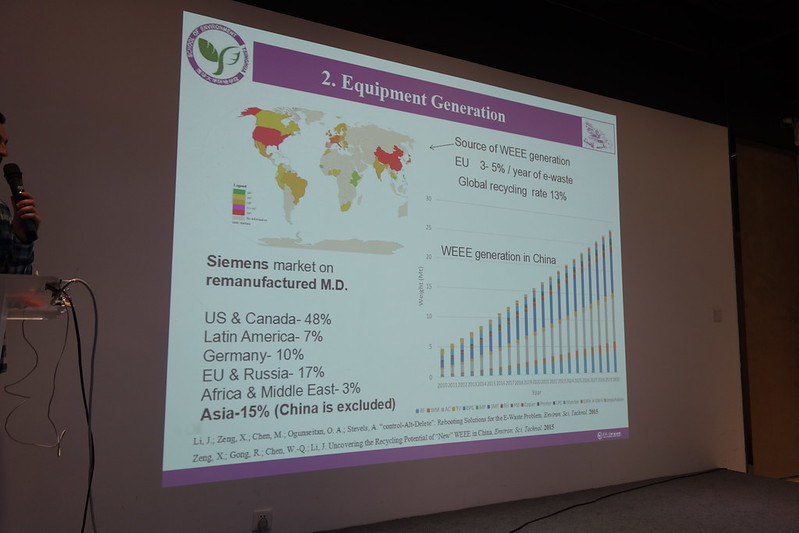
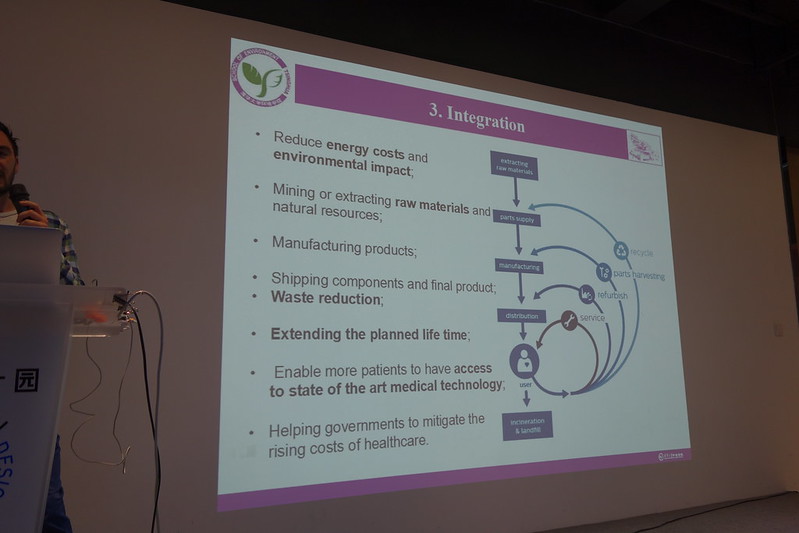
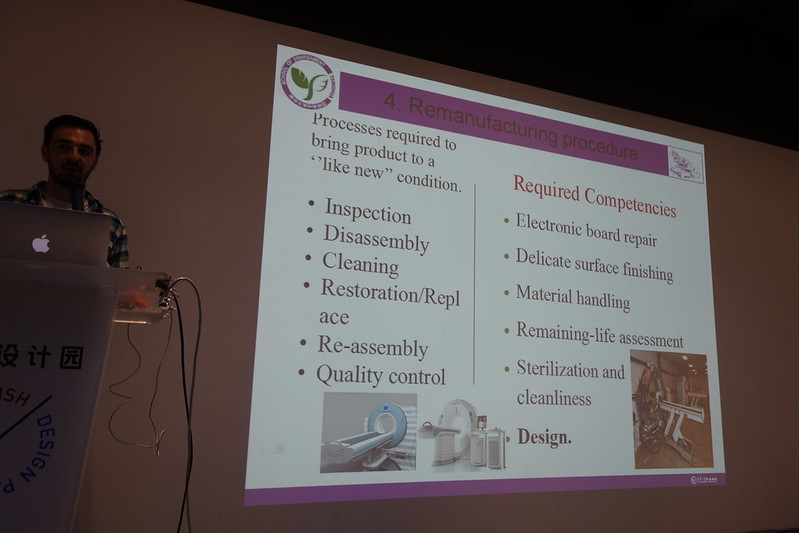
///
Malavika Jayaram (Digital Asia Hub) skypes in to talk about AI and ethics, and how they relate to IoT.

Malavika larger than life
Malavika explores the social and political aspects of connected technology. Some of the key points she makes:
- Large-scale deployments of connected technology (like AI and #iot) frequently impact marginalized group disproportionately.
- How do AI and machine learning apply to social issues? How can they be put to good use in this context?
- “If you can’t be counted, you don’t count. If you’re not connected, you don’t count.”
- The Chinese social credit system—and similar approaches everywhere—means that keeping (algorithmically) bad company would implicate you even though you might yourself be squeaky clean, like for example bad credit records.
///
Dietrich Ayala (Mozilla) speaks about apps, app fatigue, onboarding, interfaces and IoT. A wide range, fantastic presentation.
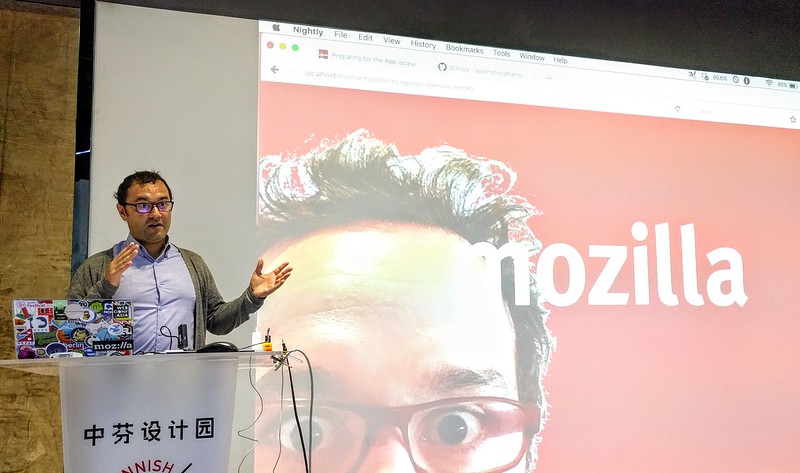
Dietrich
Here’s what I managed to write down quickly enough:
- “ZERO. The number of apps the average users installs in a month according to Google. People have app fatigue.”
- “With IoT we have a new opportunity. The room is now the computer.”
- One founder shared: 1.000 web views per app installation. 999 users left behind! It’s a choice!
- In China, QR codes make connecting easy. Outside of China, QR codes are often still considered awkward.
- QR codes and NFC are powerful connectors. But they have challenges. QR codes have to be big enough. Who scans whom? NFC needs signage to indicate it’s an option.
- Beacons are an options, very powerful, but still expensive. Onboarding is super easy, though, a pop-up notification is a well-known interaction.
- Maybe you don’t need speech to activate a thing. Noise might be enough! You can make valuable assumptions from very little data.
- Frictionless augmented reality. It’s pretty easy to do now within web pages.
Dietrich shows lots of cool demos of lightweight web-based AR demos.
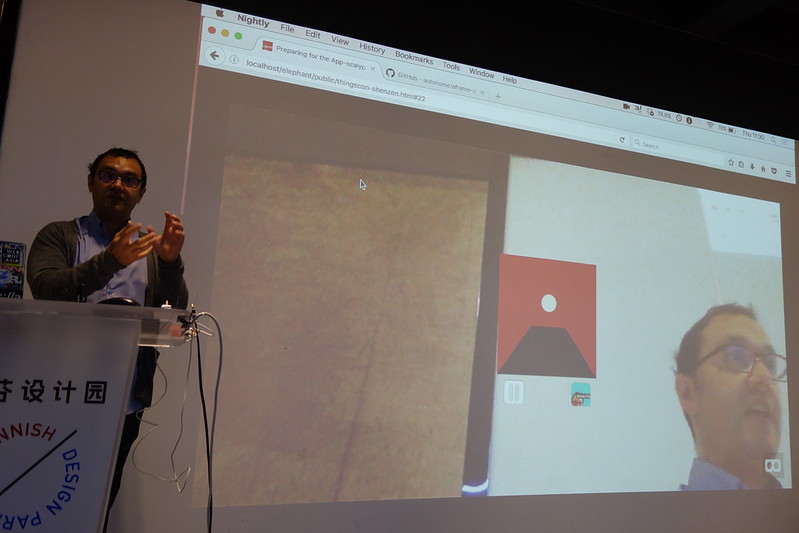
Dietrich demos an experimental AR interface for a music player
It’s becoming super easy to access user media, too:
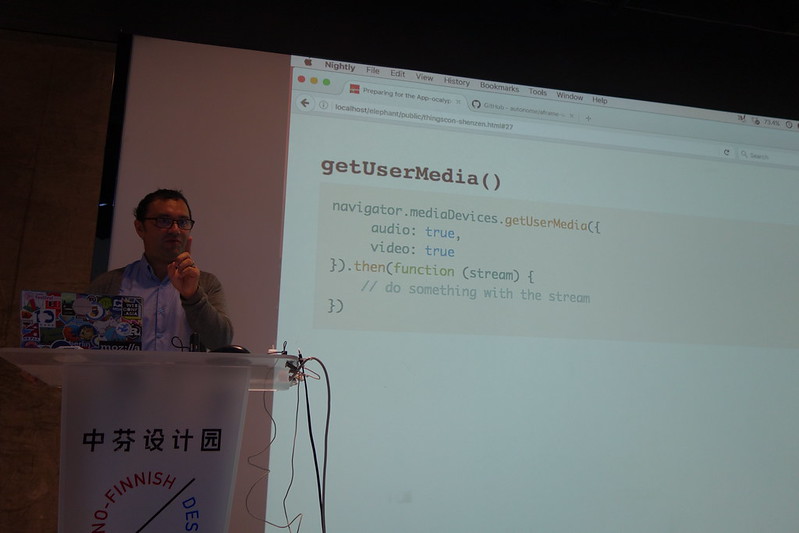
This is all it takes to access user media for AR.
This doesn’t work on iOS yet, but hopefully this year. Since the global market share of iOS is tiny compared to Android, this shouldn’t stop you.
///
Monique hosts a panel discussion with Iskander, Holly, Marcel and myself. We talk about responsible IoT, and how it can be applied in the day-to-day work we all do. Also, we try to explore if there’s a special angle that European indie IoT creators can bring in.
Since I was on the panel I can’t share any photos, but there you go.
///
Marcel gives some closing remarks:
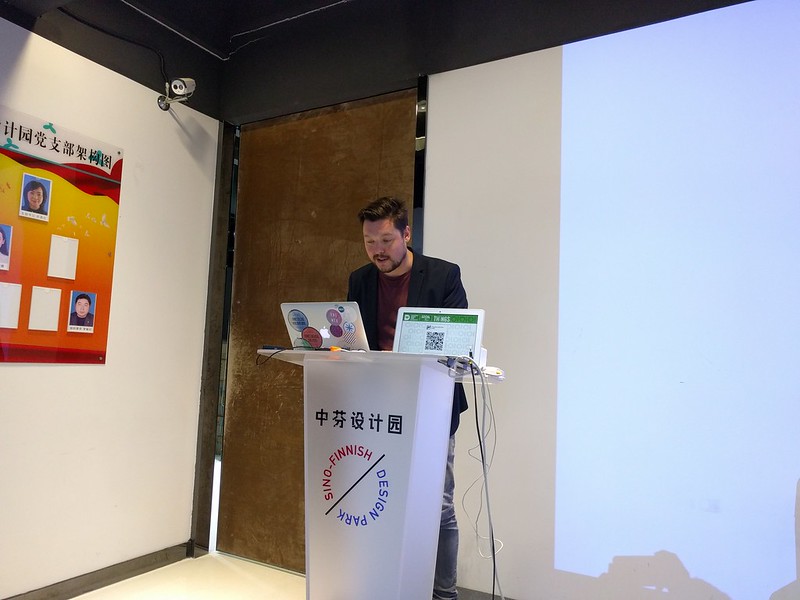
Note the second laptop in front of Marcel? It’s an impromptu hack to let people scan the QR code to join our Wechat event channel. It makes connecting with other participants incredible smooth. We should, of course, have put this QR code up on the big screen all along.
///
David runs a spontaneous session on how to source components in Shenzhen. After all, running around on the market to find parts is a lot of fun but it’s not the efficient way to find anything. Instead, Wechat and Taobao are good starting points.
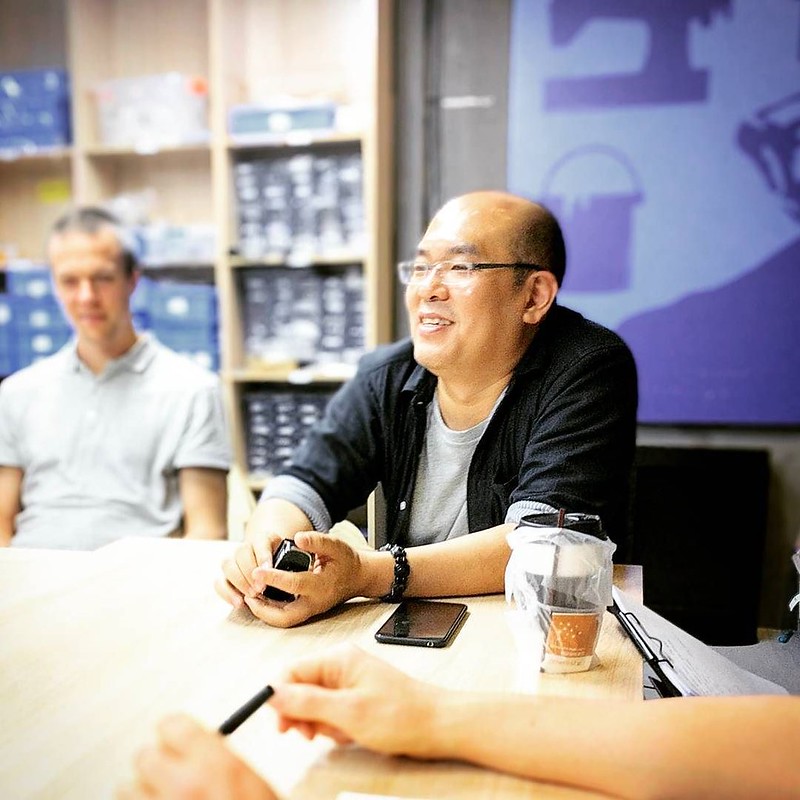
David
Tipps, strategies, useful things to know:
Shenzhen is full of so-called technical solution houses. Solution houses build very specific technical solutions, help you solve specific issues. Say find or build or adapt a certain board. Most customers don’t ask for exclusivity. So these solutions can be re-used. There are somewhere between 5-10K of them. They can help you source. You toss your requirements into a Wechat group: “Who has this?” You get a pretty good hit ratio: Either someone already has what you need, or they can help adapt it.

A solution house’s catalog.
Also, sometimes someone comes back to you and says: We’ve done this a year ago and couldn’t sell it. Are you sure you want to do this?
Wechat is the platform to find people and connect.
The timing also matters: During our last visit 6 months ago, smart bike locks were a fringe offering. Now, due to the big boom in sharing bike companies, there’s a wide range of offerings.
A lot of knowledge (technical, design, software) is in the technical solution houses. It’s often undocumented. This makes it hard to research: There might be really short roadmaps that aren’t shared. Wechat allows these providers to identify themselves and say: “Oh yes, we’re working on this, it’ll be ready in 4-6 weeks.” *Harm confirms this: Searching for bike lock companies, the team found one through Wechat and arranged for a meeting to discuss details. It was all arranged within days, if not hours. “We definitively didn’t find what we needed at the market. What we were looking for was too specific.” * These channels are for professionals. Wasting anyone’s time isn’t appreciated.
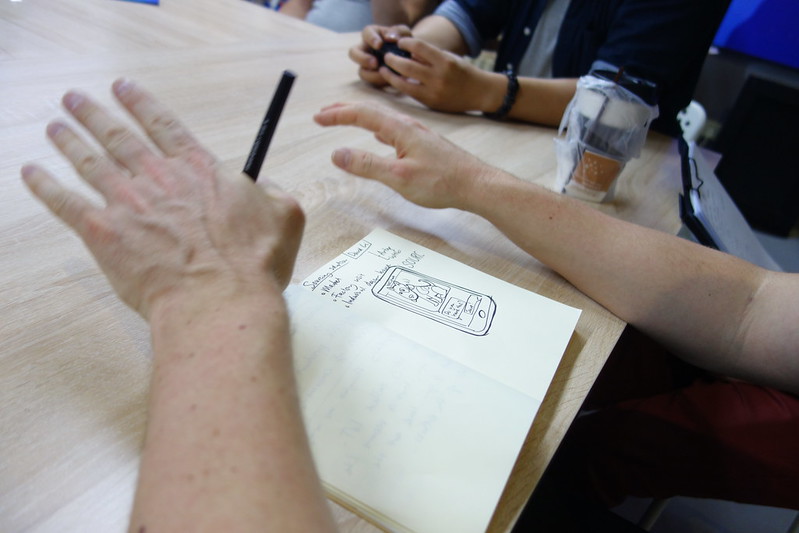
Harm’s sketchnotes are pretty awesome
Industrial design houses are also great interfaces for sourcing and more. They’re one abstraction level up, and they bring with them the connections to technical solution houses.
“There are no consultants in Shenzhen. No shipping, no money.”
Q: How about language barriers? When we visited design houses, our hosts spoke excellent English. How about solution houses? A: It’s one abstraction layer down, more in the background. The language barrier might be higher, and you’re often talking to engineers. (Design houses might offer a softer landing pad.) Wechat translation can also help if you collaborate in writing.
David: The golden days of the market are over. Used to be easy money: Source 100 phones, flip them by the afternoon with $10 margin each, you got $1.000 in your pocket.
David: We see more entrepreneurs not coming here with their giant valuations but with solid business models. It’s a good development. (It reminds me of how different the early days of web 2.0 felt compared to the craze of the dotcom boom. This sounds similar.)
Connections are built from social networking: Trust and personal recommendations/introductions. Some companies are more careful today about who to spend time and effort on, to filter out the non-serious folks. But then again, of course nobody knows how to find the 1% of great ideas.
///
We end up chatting for quite a while, then disperse: Some folks have more market to explore, others visit a design university. Some have meetings. I do a last round on the market, then people watch for a while.
On a bench, a young guy asks if he can sit next to me. I learn he works for a company that assembles phones. I ask if I can see one: It’s a rose gold Android phone, the case looks solidly made at first glance. I don’t want to dig deeper; I’m not sure if he wants to sell and don’t want to encourage him, but he does have a bag of boxed phones with him.
“It runs Android.” “Which version?” “Don’t know, I’m not involved in that part.”
We chat for a bit, then I excuse myself. He stays and finishes his bubble tea.

TIME IS UP!
///
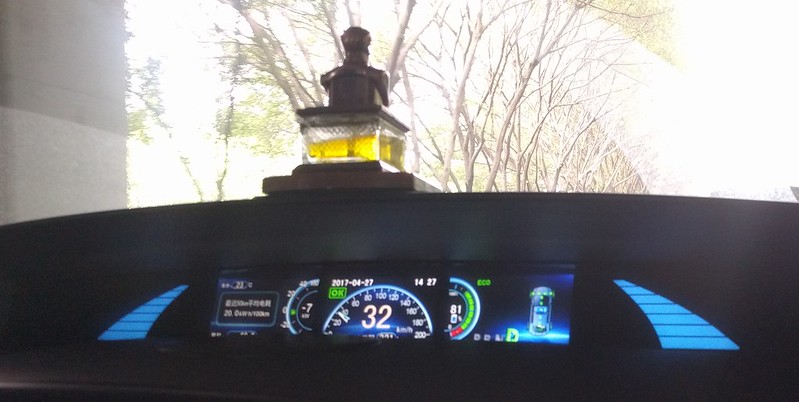
A BYD (Chinese car maker) dashboard, topped by a Mao-shaped fragrance dispense #artefactsOfShenzhen
///

A second (or maybe, uhm, third lunch snack)
///
I bump into Dietrich, who shows me his haul: A lightweight Android VR headset.

Dietrich modeling his haul
I’m looking forward to checking out the demos he’s going to build for it.
